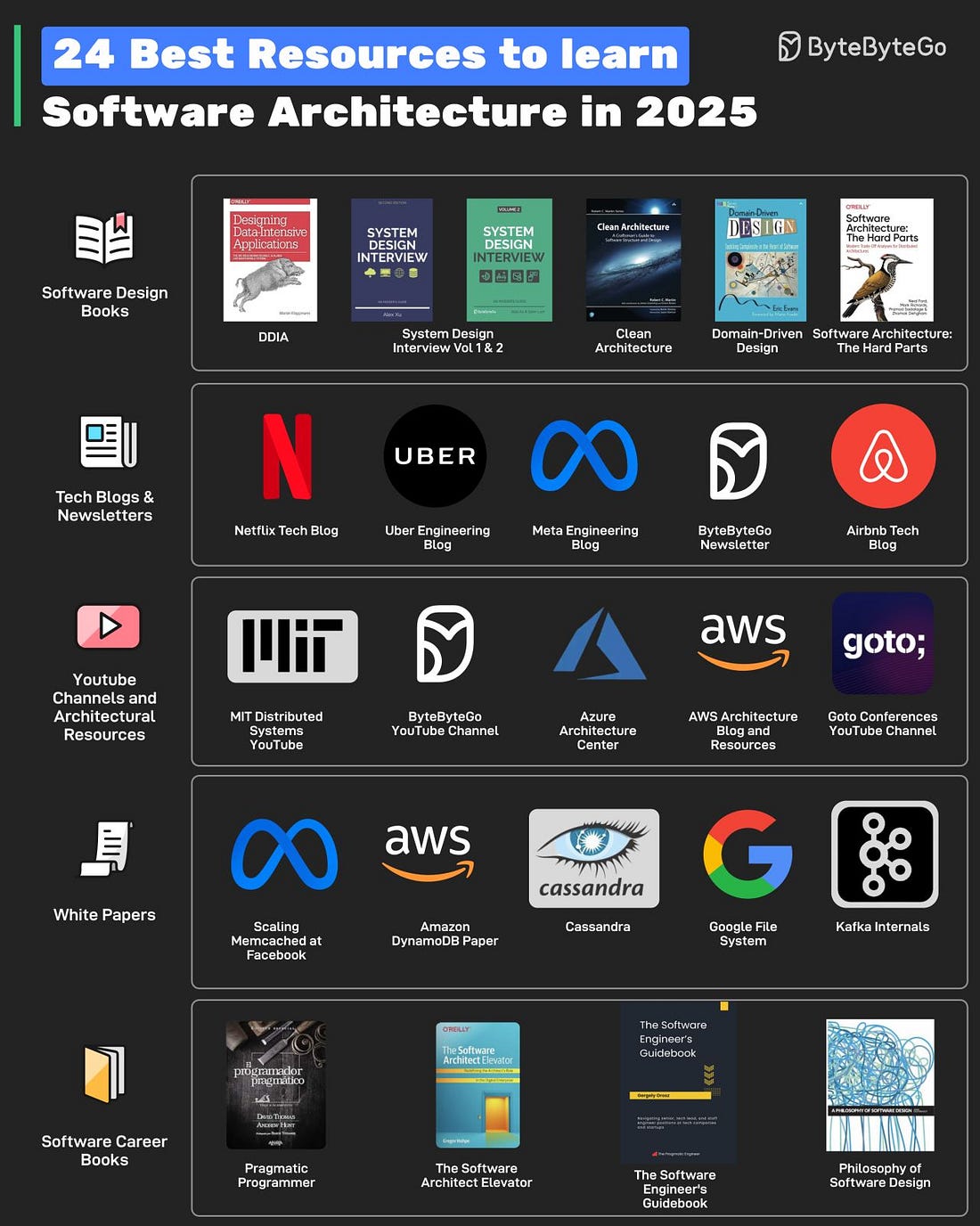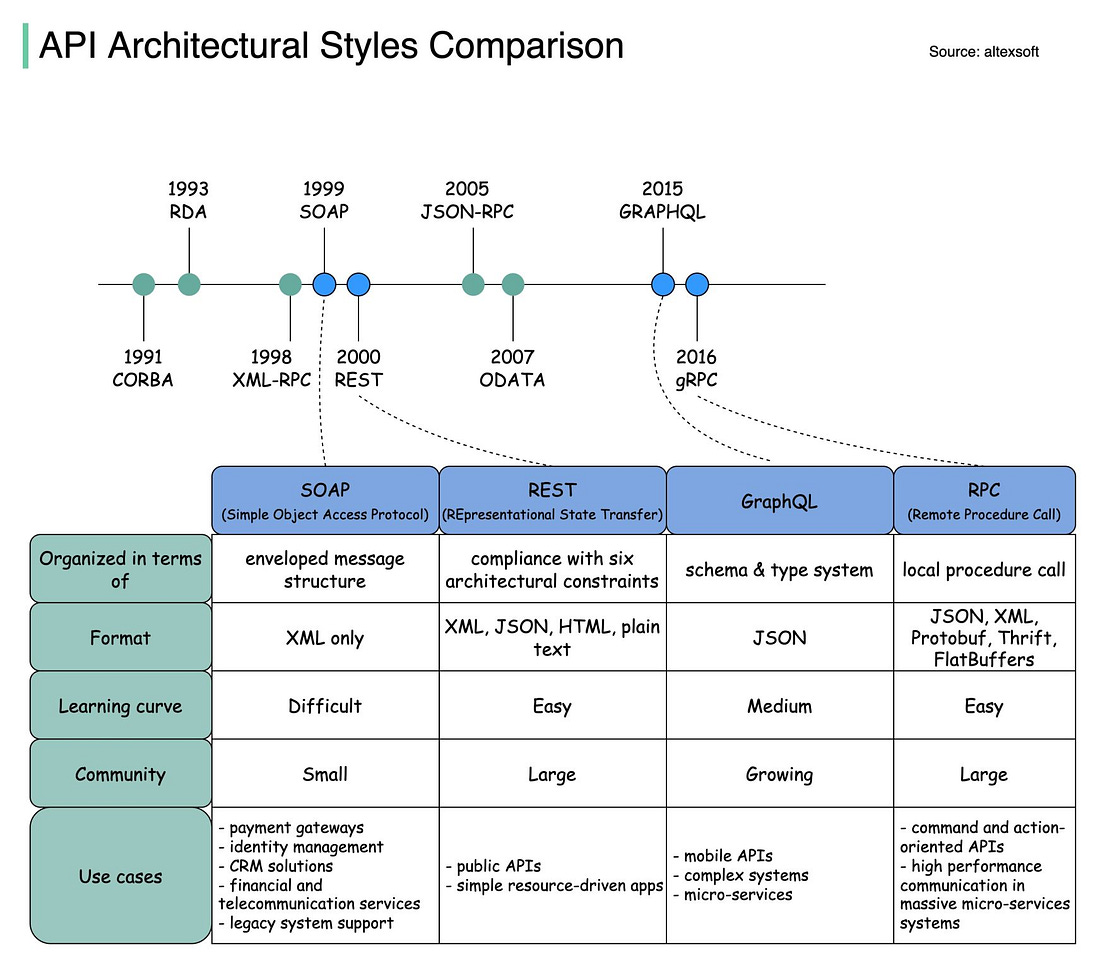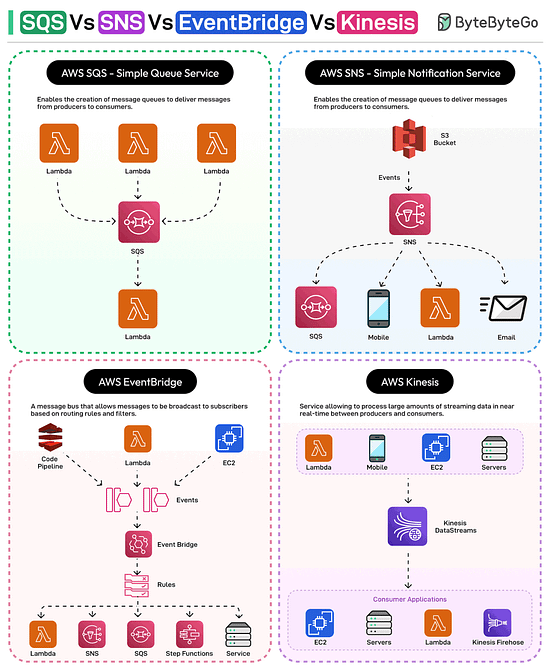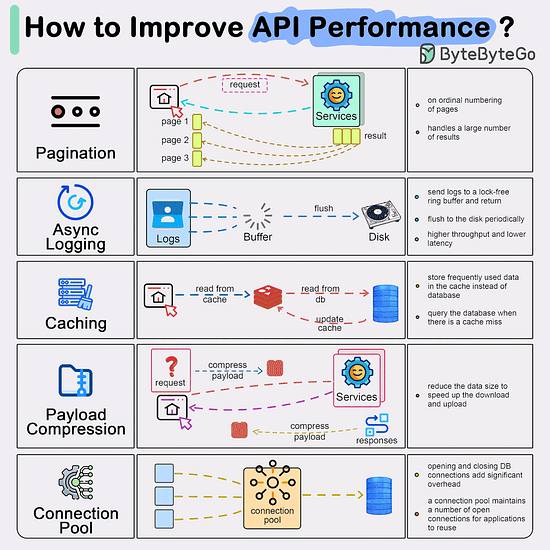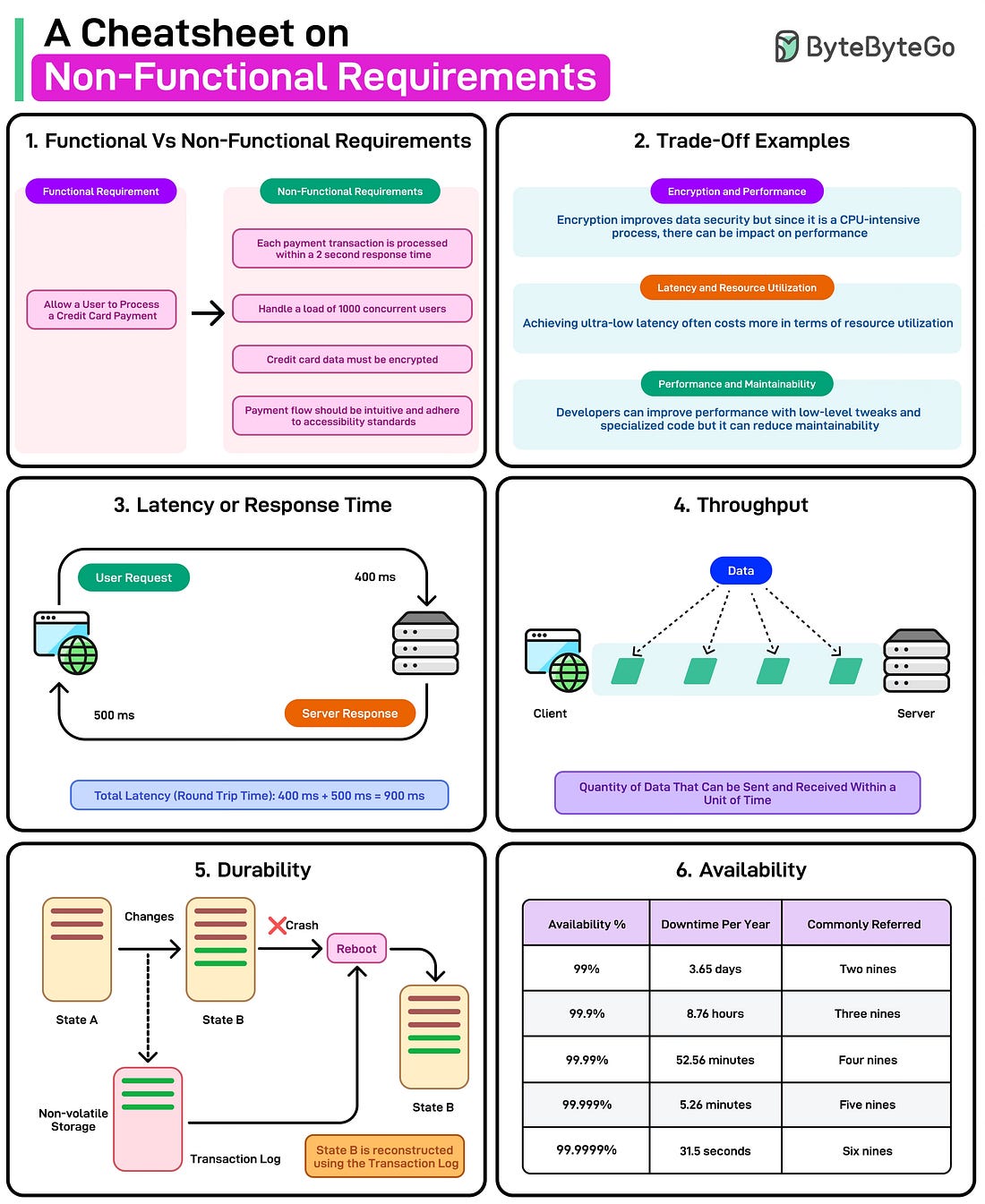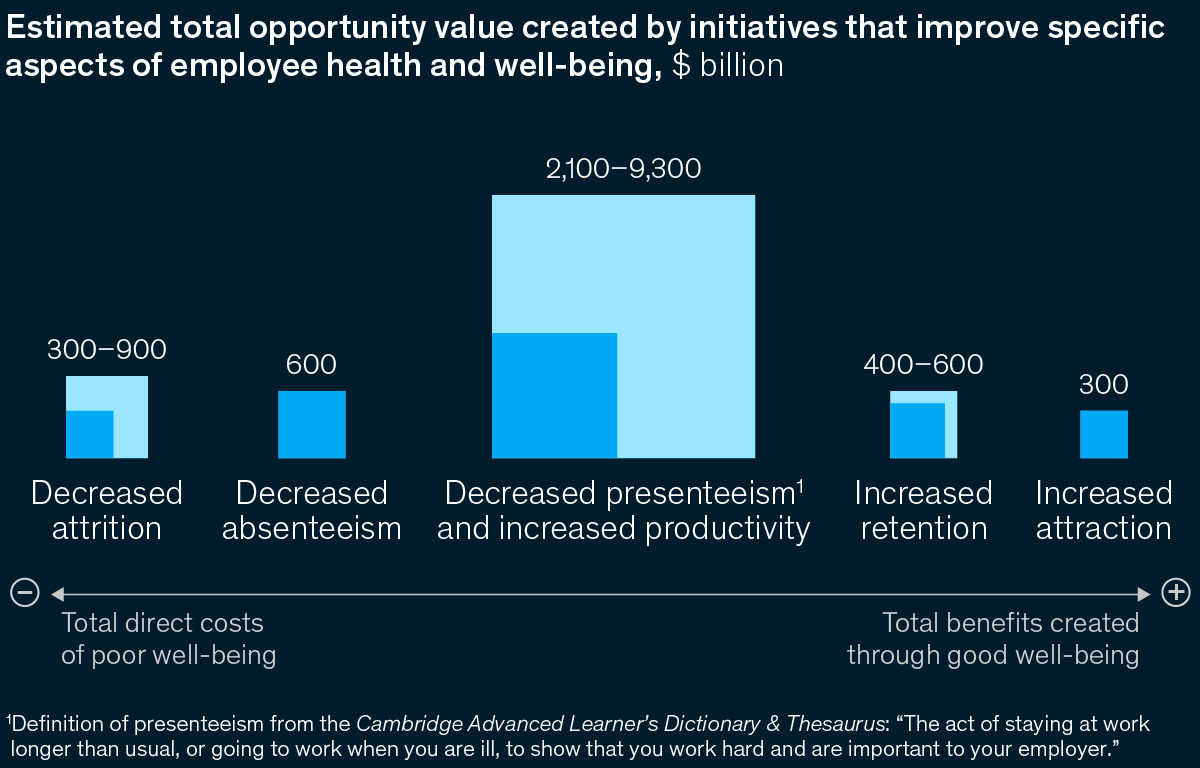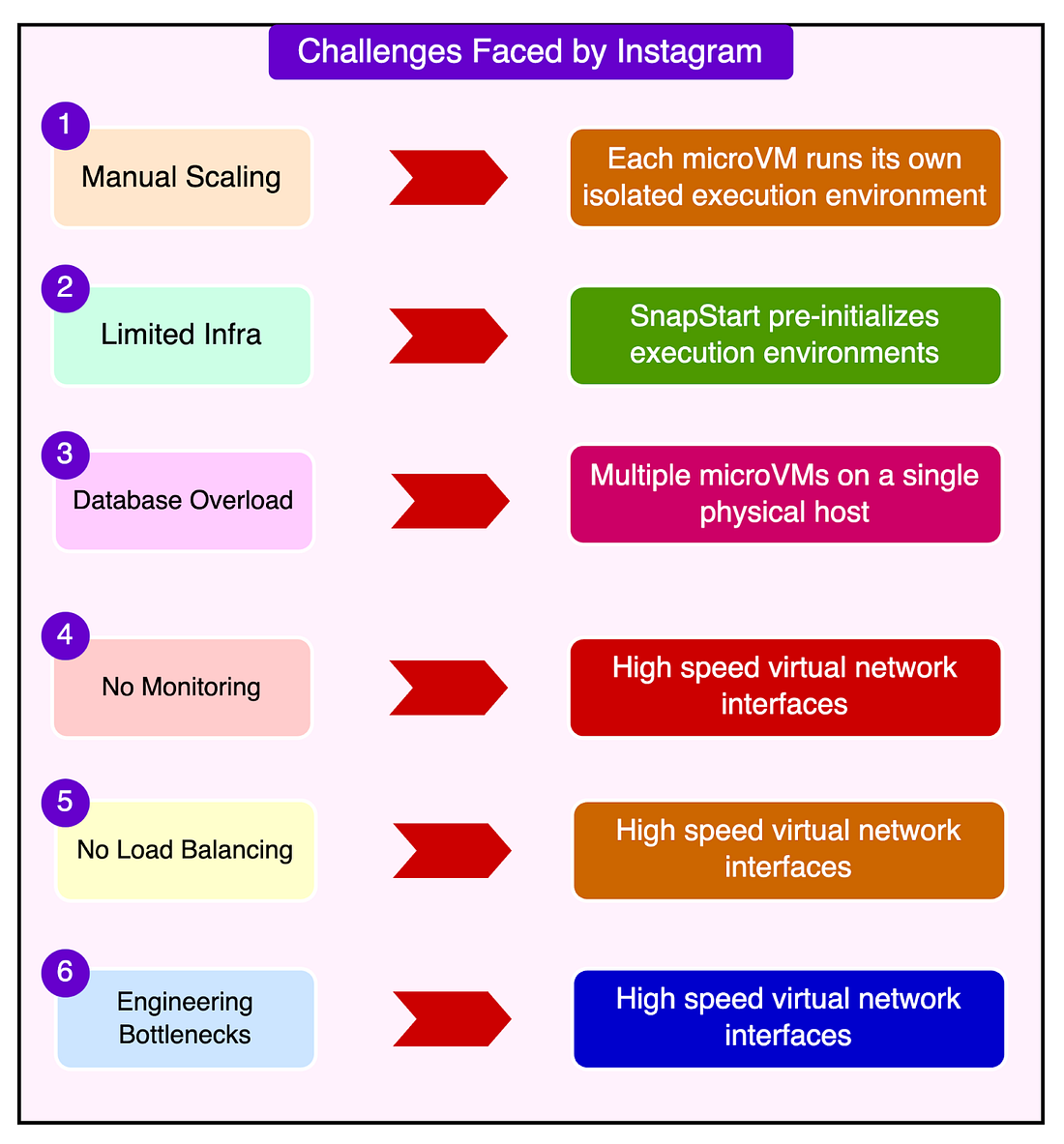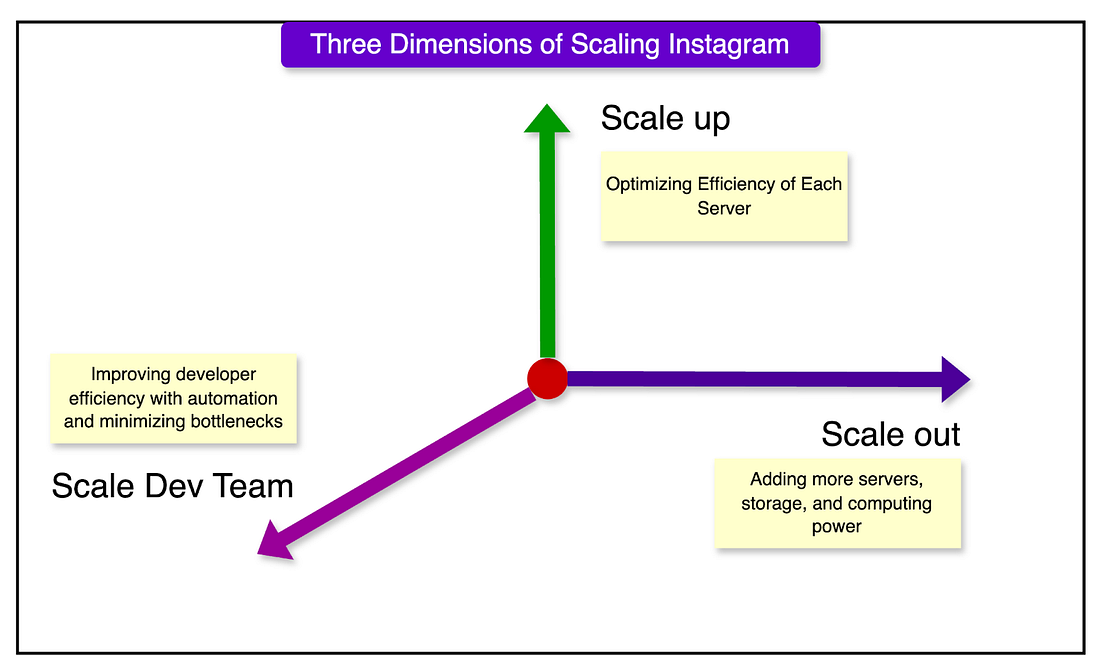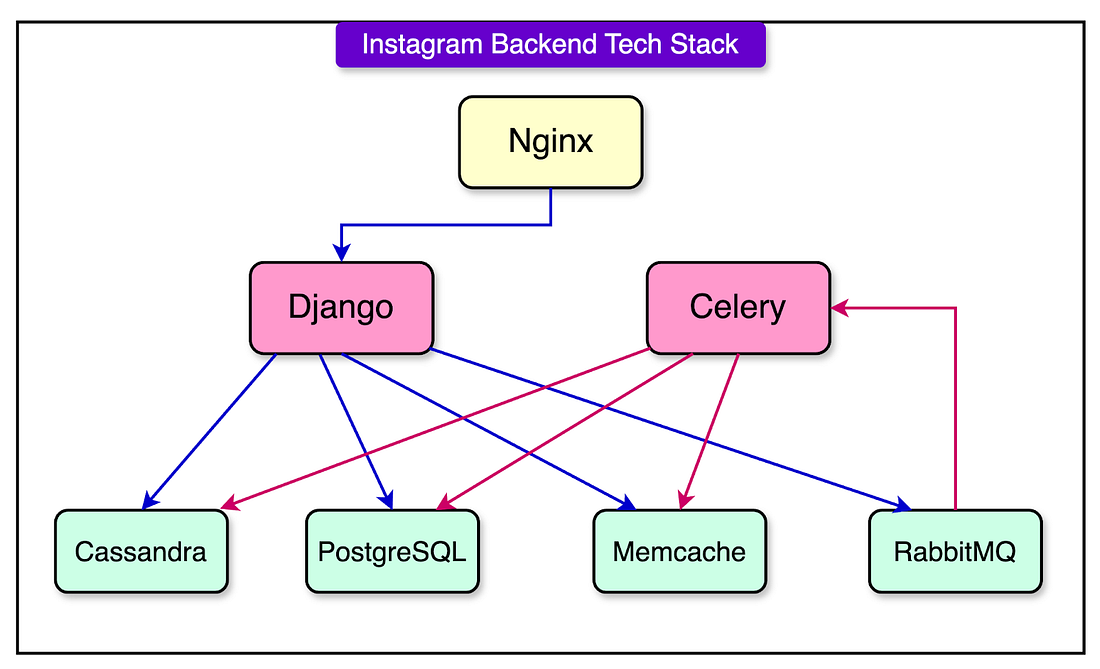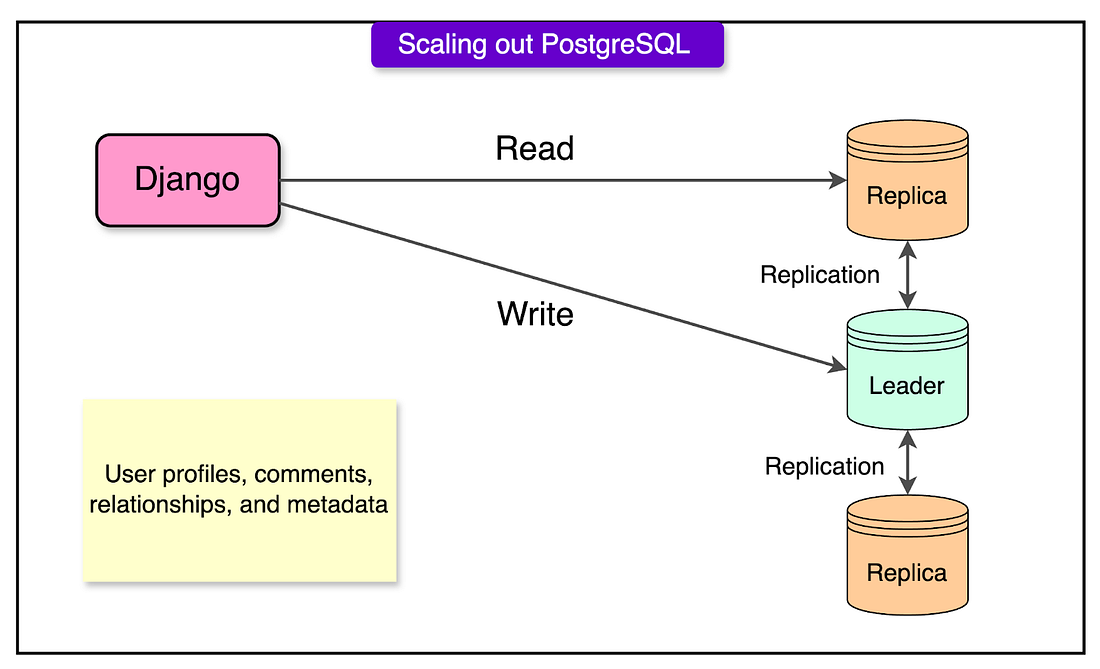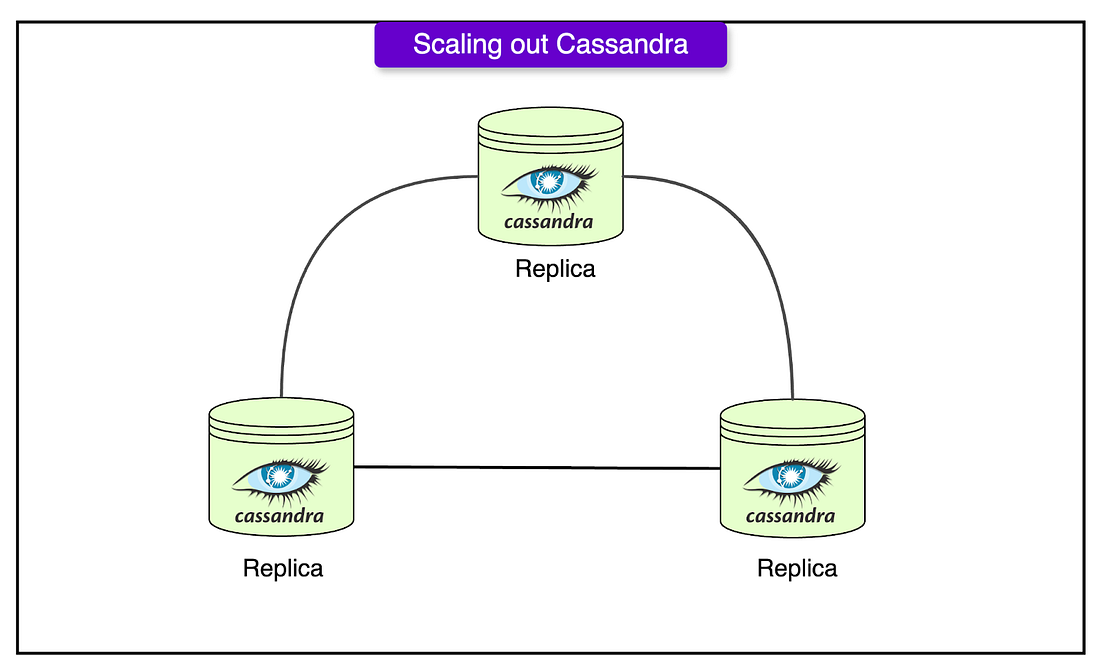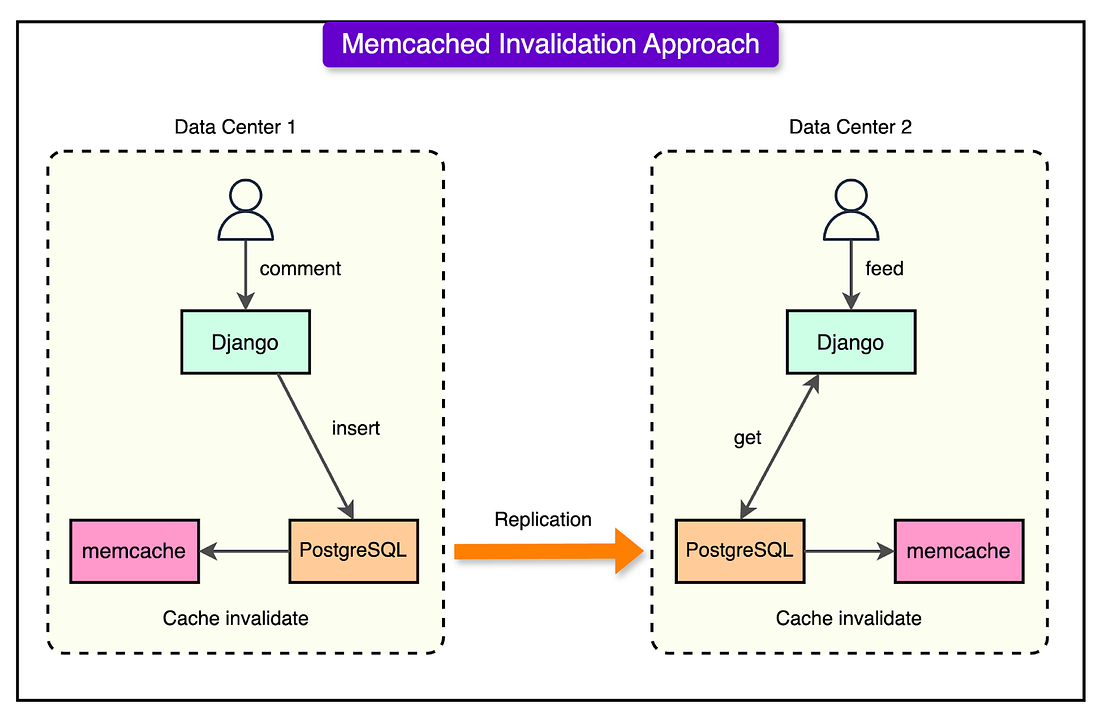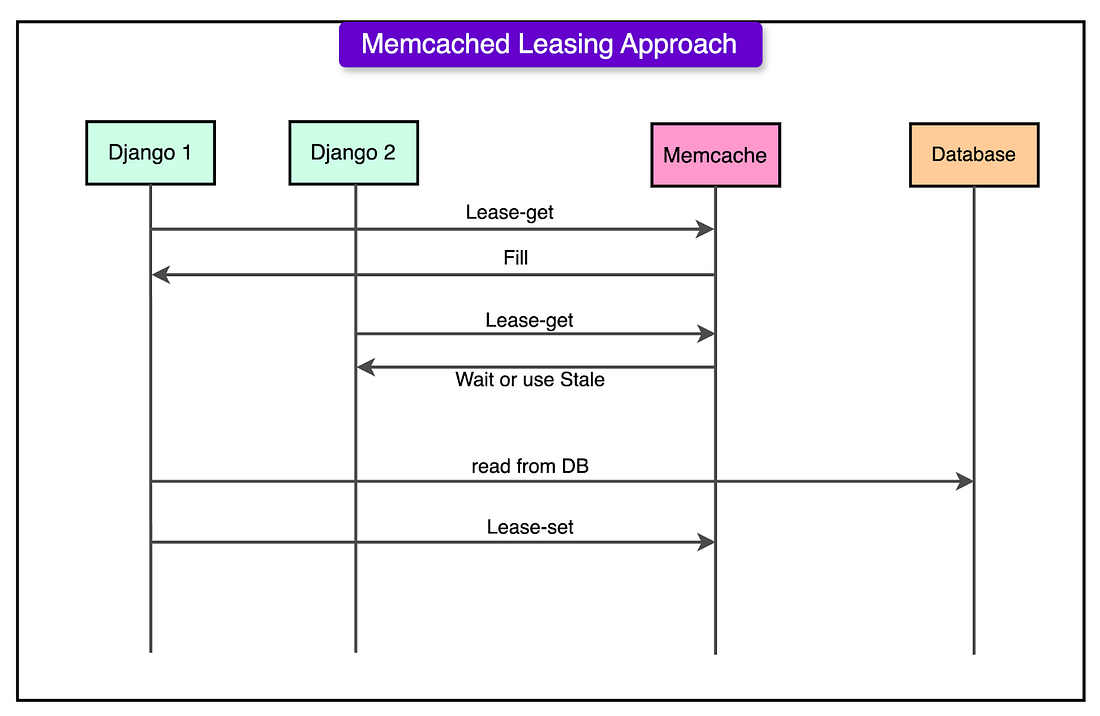Archives
- By thread 5234
-
By date
- June 2021 10
- July 2021 6
- August 2021 20
- September 2021 21
- October 2021 48
- November 2021 40
- December 2021 23
- January 2022 46
- February 2022 80
- March 2022 109
- April 2022 100
- May 2022 97
- June 2022 105
- July 2022 82
- August 2022 95
- September 2022 103
- October 2022 117
- November 2022 115
- December 2022 102
- January 2023 88
- February 2023 90
- March 2023 116
- April 2023 97
- May 2023 159
- June 2023 145
- July 2023 120
- August 2023 90
- September 2023 102
- October 2023 106
- November 2023 100
- December 2023 74
- January 2024 75
- February 2024 75
- March 2024 78
- April 2024 74
- May 2024 108
- June 2024 98
- July 2024 116
- August 2024 134
- September 2024 130
- October 2024 141
- November 2024 171
- December 2024 115
- January 2025 216
- February 2025 140
- March 2025 220
- April 2025 233
- May 2025 239
- June 2025 303
- July 2025 46
-
EP151: 24 Good Resources to Learn Software Architecture in 2025
EP151: 24 Good Resources to Learn Software Architecture in 2025
The resources can be divided into different types͏ ͏ ͏ ͏ ͏ ͏ ͏ ͏ ͏ ͏ ͏ ͏ ͏ ͏ ͏ ͏ ͏ ͏ ͏ ͏ ͏ ͏ ͏ ͏ ͏ ͏ ͏ ͏ ͏ ͏ ͏ ͏ ͏ ͏ ͏ ͏ ͏ ͏ ͏ ͏ ͏ ͏ ͏ ͏ ͏ ͏ ͏ ͏ ͏ ͏ ͏ ͏ ͏ ͏ ͏ ͏ ͏ ͏ ͏ ͏ ͏ ͏ ͏ ͏ ͏ ͏ ͏ ͏ ͏ ͏ ͏ ͏ ͏ ͏ ͏ ͏ ͏ ͏ ͏ ͏ ͏ ͏ ͏ ͏ ͏ ͏ ͏ ͏ ͏ ͏ ͏ ͏ ͏ ͏ ͏ ͏ ͏ ͏ ͏ ͏ ͏ ͏ ͏ ͏ ͏ ͏ ͏ ͏ ͏ ͏ ͏ ͏ ͏ ͏ ͏ ͏ ͏ ͏ ͏ ͏ ͏ ͏ ͏ ͏ ͏ ͏ ͏ ͏ ͏ ͏ ͏ ͏ ͏ ͏ ͏ ͏ ͏ ͏ ͏ ͏ ͏ ͏ ͏ ͏ ͏ ͏ ͏ ͏ ͏ ͏ ͏ ͏ ͏ ͏ ͏ ͏ ͏ ͏ ͏ ͏ ͏ ͏ ͏ ͏ ͏ ͏ ͏ ͏ ͏ ͏ ͏ ͏ ͏ ͏ ͏ ͏ ͏ ͏ ͏ ͏ ͏ ͏ ͏ ͏ ͏ ͏ ͏ ͏ ͏ ͏ ͏ ͏ ͏ ͏ ͏ ͏ ͏ ͏ ͏ ͏ Forwarded this email? Subscribe here for more✂️Cut your QA cycles down to minutes with QA Wolf (Sponsored)
If QA is a bottleneck on your software engineering team and you’re releasing slowly because of it, you need to check out QA Wolf.
Their fully-managed service gets engineering teams to 80% automated end-to-end test coverage and their AI-native platform helps dev teams ship 5x faster by reducing QA cycles from hours to minutes.
QA Wolf takes testing off your plate. They can get you:
Unlimited parallel test runs
24-hour maintenance and on-demand test creation
Human-verified bug reports sent directly to your team
Zero flakes guarantee
The benefit? No more manual E2E testing. No more slow QA cycles. No more bugs reaching production.
With QA Wolf, Drata’s team of 80+ engineers achieved 4x more test cases and 86% faster QA cycles.
This week’s system design refresher:
24 Good Resources to Learn Software Architecture in 2025
SOAP vs REST vs GraphQL vs RPC
SQS vs SNS vs EventBridge vs Kinesis
Top 5 common ways to improve API performance
xAI’s Grok-3 One-Pager
SPONSOR US
24 Good Resources to Learn Software Architecture in 2025
The resources can be divided into different types such as:
Software Design Books
Some books that can help are DDIA, System Design Volume 1 & 2, Clean Architecture, Domain-Driven Design, and Software Architecture: the Hard PartsTech Blogs and Newsletters
Read technical blogs by companies like Netflix, Uber, Meta, and Airbnb. Also, the ByteByteGo newsletter provides insights into software design every week.YouTube Channels and Architectural Resources
YouTube channels like MIT Distributed Systems, Goto Conferences, and ByteByteGo can help with software architecture and system design. Azure Architecture Center and AWS Architecture Blog are other important resources.WhitePapers
For deeper insights, read whitepapers like Facebook Memcache Scaling, Cassandra, Amazon DynamoDB, Kafka, and Google File System.Software Career Books
A Software Architect also needs to develop holistic skills. Books about software career aspects such as Pragmatic Programmer, The Software Architect Elevator, The Software Engineer's Guidebook, and Philosophy of Software Design can help.
Over to you: Which other resources will you add to the list?
SOAP vs REST vs GraphQL vs RPC
The diagram below illustrates the API timeline and API styles comparison.
Over time, different API architectural styles are released. Each of them has its own patterns of standardizing data exchange.
You can check out the use cases of each style in the diagram.SQS vs SNS vs EventBridge vs Kinesis
AWS SQS: It is a fully managed message queuing service that helps decouple communication between distributed components.
AWS SNS: A fully managed publish/subscribe messaging service using topics to send messages to multiple subscribers or endpoints (such as email, Lambda, SQS, and so on).
AWS EventBridge: It is a serverless event bus that facilitates the routing of events between AWS services, and applications based on specific routing rules and filters.
AWS Kinesis Data Streams: A real-time data streaming service that captures, processes, and analyzes data in near real-time.
How can you choose which service to use?
Here are some basic tips and examples:
For massive amounts of events like a clickstream from an application use Kinesis Data Stream
For events processed by a single consumer like an image processing job, SQS is a better choice.
For sending messages and notifications, SNS is a great choice.
For system events such as a new user registration that multiple services must receive and react to, use EventBridge.
Over to you: Have you used SQS, SNS, EventBridge, or Kinesis?
Top 5 common ways to improve API performance
Result Pagination:
This method is used to optimize large result sets by streaming them back to the client, enhancing service responsiveness and user experience.
Asynchronous Logging:
This approach involves sending logs to a lock-free buffer and returning immediately, rather than dealing with the disk on every call. Logs are periodically flushed to the disk, significantly reducing I/O overhead.
Data Caching:
Frequently accessed data can be stored in a cache to speed up retrieval. Clients check the cache before querying the database, with data storage solutions like Redis offering faster access due to in-memory storage.
Payload Compression:
To reduce data transmission time, requests and responses can be compressed (e.g., using gzip), making the upload and download processes quicker.
Connection Pooling:
This technique involves using a pool of open connections to manage database interaction, which reduces the overhead associated with opening and closing connections each time data needs to be loaded. The pool manages the lifecycle of connections for efficient resource use.
Over to you: What other ways do you use to improve API performance?xAI’s Grok-3 One-Pager
Grok 3 was unveiled on February 17. According to Elon Musk, it is “the smartest AI on Earth.”
But what makes it so powerful?
Grok 3 has been trained on the Colossus supercomputer with 100K Nvidia H100 GPUs. According to one stat, it has been trained for 200 million GPU hours. The key capabilities of Grok 3 are coding, science research, problem-solving, creating marketing campaigns, personalized assistance, and API integration.
Some special features of Grok 3 are:DeepSearch: Allows Grok to search the web and X posts for real-time data and information.
Think Mode: Decompose complex queries into steps just like human problem-solving.
Big Brain Mode: A heavy-duty mode for intensive tasks like simulations, data analysis, or reasoning.
Here’s how Grok 3 possibly works:
Grok 3 supports multi-modal inputs. The user can ask questions as text, upload images, or talk to Grok. The inputs are tokenized to initiate processing.
Synthetic data training enhances the query interpretation.
This is fed to the core transformer model that analyzes the input.
The core transformer issues a search directive to DeepSearch to retrieve necessary information from the web or real-time X data.
Next, a self-correct process ensures accuracy through an internal feedback loop.
Depending on the user’s input, the Think Mode or Big Brain Mode refines the responses as required. It might again use DeepSearch to find more information.
The answers are delivered to the user in a multimodal manner.
Note that these details are based on piecing together information from xAI blogs about Grok and new feature announcements. More details may be revealed in the coming days.
Over to you: Have you used xAI’s Grok 3?
SPONSOR US
Get your product in front of more than 1,000,000 tech professionals.
Our newsletter puts your products and services directly in front of an audience that matters - hundreds of thousands of engineering leaders and senior engineers - who have influence over significant tech decisions and big purchases.
Space Fills Up Fast - Reserve Today
Ad spots typically sell out about 4 weeks in advance. To ensure your ad reaches this influential audience, reserve your space now by emailing sponsorship@bytebytego.com.
Like
Comment
Restack
© 2025 ByteByteGo
548 Market Street PMB 72296, San Francisco, CA 94104
Unsubscribe
by "ByteByteGo" <bytebytego@substack.com> - 11:35 - 22 Feb 2025 -
BEIJING HOLTOP/Professional factory with 20+ years of experiences for HVAC system units from China
Dear info,
Good morning!
I just visited your website, and know that you are the leading wholesaler/importer in your local market for HVAC industry, with a prestigious brand.
You may be happy to find a new reliable OEM/ODM supplier of HVAC system heat recovery ventilation units with superior quality & Reasonable prices. You can select from an abundant variety of our ERVs/HRVs and AHU with different specifications and installation types.
Since 2002, our company specialized in producing and supplying Energy Recovery Ventilation(ERV), Air Handling Units(AHU), chillers, air conditioners, and Plate & Rotary Heat Exchangers, etc HVAC products. Our company has the largest ERV/HRV manufacturing base in China. We have ISO9001/ISO14001/ISO45001 certification and our products have CE/CSA/CB certifications. We not only have HOLTOP brand, but also we are ERV/HRV ODM/OEM supplier of Johnson Controls-York, Mitsubishi, Hisense Hitachi, Midea...etc in China.
I am confident that when you work with us, you will have the same satisfaction likes our other old customers. To enable you to get a good understanding of our quality and service, we would like to extend a very special offer for your first order, with 5% (only limited to the first container).If interested, please email me directly to talk more. In the next email, I will attach you the product catalogs. Please tell me what items are more saleable for you.
Best regards,Jun Gao
Beijing Holtop Air Conditioning Co.,Ltd
by "Apolloder Frimmel" <apolloderfrimmel@gmail.com> - 04:22 - 21 Feb 2025 -
Are deals so back?
The Shortlist
Emerging ideas for leaders Curated by Alex Panas, global leader of industries, & Axel Karlsson, global leader of functional practices and growth platforms
Welcome to the latest edition of the CEO Shortlist, a biweekly newsletter of our best ideas for the C-suite. This week, we’re sharing key findings from the latest edition of our annual report on global M&A. We appreciate the opportunity to connect and hope you find our perspectives novel and insightful. Please let us know what you think! You can reach us at Alex_Panas@Mckinsey.com and Axel_Karlsson@Mckinsey.com. Thank you, as ever.
—Alex and Axel
Share these insights
This email contains information about McKinsey’s research, insights, services, or events. By opening our emails or clicking on links, you agree to our use of cookies and web tracking technology. For more information on how we use and protect your information, please review our privacy policy.
You received this email because you subscribed to The CEO Shortlist newsletter.
Copyright © 2025 | McKinsey & Company, 3 World Trade Center, 175 Greenwich Street, New York, NY 10007
by "McKinsey CEO Shortlist" <publishing@email.mckinsey.com> - 04:38 - 21 Feb 2025 -
Do You Offer Freight Services?
Dear Partner,
Good day!
Hope this email doesn't interrupt you. This is Hina, the Overseas Manager from GT Network.
We're an online global FF network, connecting the members with inquiries & quotations & other valuable information.
Currently we have 3500+ members from 140+ countries.
Now since the inquiries from our GT members are increasing rapidly, I really hope we can have a chance to cooperate together, and GT sincerely wants to assist you to cover the whole market.
You shall enjoy below special advantages in GT:- We have few agents in your region in our network, so it is easy for you to stand out and there is no competition.
- For every inquiry you will get the chance to be the first to quote.
- You just need one or two orders to gain the feedback.
- You can enjoy the bottom price to join GT.
If you are interested please let me know.Sincerely waiting for your early reply!
Kind regards,
Hina






Hina (Overseas Manager)
GT Co., Ltd.
Web:www.gtran.net
Email:gt06@gtran.net
WhatsApp:+8617362373479 Skype:gt06@gtran.net
Mobile:17362373479
by "Hina Liu" <gt06@gtran.net> - 02:11 - 21 Feb 2025 -
The future of people management
On McKinsey Perspectives
Next steps for companies Brought to you by Alex Panas, global leader of industries, & Axel Karlsson, global leader of functional practices and growth platforms
Welcome to the latest edition of Only McKinsey Perspectives. We hope you find our insights useful. Let us know what you think at Alex_Panas@McKinsey.com and Axel_Karlsson@McKinsey.com.
—Alex and Axel
—Edited by Belinda Yu, editor, Atlanta
This email contains information about McKinsey's research, insights, services, or events. By opening our emails or clicking on links, you agree to our use of cookies and web tracking technology. For more information on how we use and protect your information, please review our privacy policy.
You received this email because you subscribed to the Only McKinsey Perspectives newsletter, formerly known as Only McKinsey.
Copyright © 2025 | McKinsey & Company, 3 World Trade Center, 175 Greenwich Street, New York, NY 10007
by "Only McKinsey Perspectives" <publishing@email.mckinsey.com> - 01:33 - 21 Feb 2025 -
My FHL 10 keynote inside! (listen now)
A little surprise… If you’ve ever felt called to something bigger, this is for you…OK, I just got back from Vegas, and that was the most amazing FHL ever!
Like, I knew it was going to be memorable, but I had no idea just how incredible the whole week would be!
So many ‘a-ha’ breakthrough moments… so many amazing marketing tactics… and SOOOO many emotions!!
Ah, it was amazing. I can't stop thinking about it and yet I’m trying to relax (...and for someone like me, that can be tough! ;)
Now, if you missed FHL 10… the last dance… I have some ways for you to hear all the presentations - coming out soon, so keep an eye on your email inbox. ;)
But, before that hits your inbox…
I want to make sure you get a chance to listen to my latest podcast episode!!!
Actually…
This is more than a podcast episode.. It’s my intro speech and final Funnel Hacking LIVE 10 keynote!
LISTEN TO MY FHL 10 KEYNOTE PRESENTATION ON APPLE HERE →After ten years, thousands of entrepreneurs, and countless life-changing moments, I had one last chance to stand on that stage and deliver the message I felt mattered most.
And trust me, I thought about this for months…
If I could leave you with just one thing, it’s this…LISTEN TO MY FHL 10 KEYNOTE PRESENTATION ON APPLE HERE →
Here’s just a quick sneak peek:
-
The hero’s journey every entrepreneur must take if you TRULY want to step into your purpose and change the world!
- Why fear always shows up before a breakthrough… and how to transform that fear into a steely-eyed determination that’ll get you what you WANT!
The little-known (and perhaps backward way) to discover YOUR definite purpose and pursue it with INTENSE, obsessive conviction!
-
Marketing “Sherpa”?? Why THIS type of “guide” can change everything for your business… and how to locate YOUR specific ‘mentor.’
- What it really means to “serve” - and how you can tell WITHIN YOU that you’re exactly where you need to be… surrounded by YOUR people you’re meant to serve.
- AND SO MUCH MORE!! Including how to destroy the dreaded "Entrepreneur Hesitation” that plagues almost every entrepreneur or marketer who’s about to make some MAJOR strides in their business!
LISTEN TO MY FHL 10 KEYNOTE PRESENTATION ON APPLE HERE →
So, whatever you’re doing right now… pause for a sec… go ahead and throw your buds/headphones on.
I promise you this – give it a listen and I bet you’ll walk away with at least 3 big ‘a-ha’s’ you can apply to your business and experience results FAST!
LISTEN TO MY FHL 10 KEYNOTE PRESENTATION ON APPLE HERE →
(And while you’re there, make sure to subscribe to my podcast so you’ll always be on top of the latest strategies for growing your business!)
Those who you’ve called to serve are waiting for your message.
So, step into your calling…
Russell Brunson
P.S. - Don’t forget, you’re just one funnel away…
Marketing Secrets
3443 W Bavaria St
Eagle, ID 83616
United States
by "Russell Brunson" <newsletter@marketingsecrets.com> - 09:43 - 20 Feb 2025 -
The hero’s journey every entrepreneur must take if you TRULY want to step into your purpose and change the world!
-
Cost-Effective Computer Accessories for Your Business
Dear info,
I hope you're having a great day.
At Shenzhen Tianfeng International, we offer competitive pricing without compromising on quality. Our hard drives, PC motherboards, and power supplies are manufactured to provide high performance at an affordable cost.
By partnering with us, you can access high-quality computer accessories that enhance your product offerings while reducing your operational costs. I would love to discuss how we can help your business grow with our solutions.
Best Wishes,
Candy
whatsapp: + 86 18319068061Shenzhen Tianfeng International Technology Co., Ltd.
Website:https://www.skywindintl.com/
Address: 802, Fucheng Digital Innovation Park, No. 15, Shijing Road, Fumin Community, Fucheng Street, Shenzhen, Guangdong, China
by "OFfield Byrn" <byrnoffield@gmail.com> - 07:23 - 20 Feb 2025 -
Returning to the office? Focus more on practices and less on the policy
How companies are doing Brought to you by Alexis Krivkovich (Alexis_Krivkovich@McKinsey.com) and Dana Maor (Dana_Maor@McKinsey.com), global leaders of McKinsey’s People & Organizational Performance Practice
New from McKinsey Quarterly
This email contains information about McKinsey’s research, insights, services, or events. By opening our emails or clicking on links, you agree to our use of cookies and web tracking technology. For more information on how we use and protect your information, please review our privacy policy.
You received this email because you subscribed to our McKinsey Quarterly alert list.
Copyright © 2025 | McKinsey & Company, 3 World Trade Center, 175 Greenwich Street, New York, NY 10007
by "McKinsey & Company" <publishing@email.mckinsey.com> - 02:54 - 20 Feb 2025 -
Non-Functional Requirements: The Backbone of Great Software - Part 2
Non-Functional Requirements: The Backbone of Great Software - Part 2
Non-functional requirements (NFRs) are as critical as functional requirements because they define a system's qualities and operational parameters.͏ ͏ ͏ ͏ ͏ ͏ ͏ ͏ ͏ ͏ ͏ ͏ ͏ ͏ ͏ ͏ ͏ ͏ ͏ ͏ ͏ ͏ ͏ ͏ ͏ ͏ ͏ ͏ ͏ ͏ ͏ ͏ ͏ ͏ ͏ ͏ ͏ ͏ ͏ ͏ ͏ ͏ ͏ ͏ ͏ ͏ ͏ ͏ ͏ ͏ ͏ ͏ ͏ ͏ ͏ ͏ ͏ ͏ ͏ ͏ ͏ ͏ ͏ ͏ ͏ ͏ ͏ ͏ ͏ ͏ ͏ ͏ ͏ ͏ ͏ ͏ ͏ ͏ ͏ ͏ ͏ ͏ ͏ ͏ ͏ ͏ ͏ ͏ ͏ ͏ ͏ ͏ ͏ ͏ ͏ ͏ ͏ ͏ ͏ ͏ ͏ ͏ ͏ ͏ ͏ ͏ ͏ ͏ ͏ ͏ ͏ ͏ ͏ ͏ ͏ ͏ ͏ ͏ ͏ ͏ ͏ ͏ ͏ ͏ ͏ ͏ ͏ ͏ ͏ ͏ ͏ ͏ ͏ ͏ ͏ ͏ ͏ ͏ ͏ ͏ ͏ ͏ ͏ ͏ ͏ ͏ ͏ ͏ ͏ ͏ ͏ ͏ ͏ ͏ ͏ ͏ ͏ ͏ ͏ ͏ ͏ ͏ ͏ ͏ ͏ ͏ ͏ ͏ ͏ ͏ ͏ ͏ ͏ ͏ ͏ ͏ ͏ ͏ ͏ ͏ ͏ ͏ ͏ ͏ ͏ ͏ ͏ ͏ ͏ ͏ ͏ ͏ ͏ ͏ ͏ ͏ ͏ ͏ ͏ ͏ Forwarded this email? Subscribe here for moreLatest articles
If you’re not a subscriber, here’s what you missed this month.
To receive all the full articles and support ByteByteGo, consider subscribing:
Non-functional requirements (NFRs) are as critical as functional requirements because they define a system's qualities and operational parameters.
Functional requirements specify what a software product should do (for example, “users must be able to log in”). However, non-functional requirements define how well it must accomplish these tasks under real-world conditions (for example, “the login process should respond within two seconds under peak load” or “all user credentials must be encrypted and stored securely”).
Together, functional and non-functional requirements create a foundation for building great software systems.
In Part 1 of this topic, we also looked at trade-offs in non-functional requirements and the architectural impact of these requirements. Some key learning points from Part 1 were as follows:
Non-functional requirements determine a system's performance in areas such as scalability, response time, performance, security, etc., ensuring it meets quality standards and user expectations beyond mere functionality.
Functional requirements focus on what the system should do, while non-functional requirements define how well it operates under real-world conditions.
Optimizing one NFR (for example, performance) can negatively impact others (for example, maintainability), requiring a balanced approach based on project goals and constraints.
Non-functional needs (like scalability and availability) heavily influence architecture choice. For example, choosing microservices for high availability or plugin-based designs for modifiability.
In this article (Part 2), we’ll go further and look at some of the most important NFRs that should be considered while building systems.
Key NFRs to Consider
Some key non-functional requirements that should be considered while designing an application are as follows:
Response Time/Latency...

Continue reading this post for free in the Substack app
Like
Comment
Restack
© 2025 ByteByteGo
548 Market Street PMB 72296, San Francisco, CA 94104
Unsubscribe
by "ByteByteGo" <bytebytego@substack.com> - 11:34 - 20 Feb 2025 -
Cafe POS System
Hi.We have released our latest Cafe POS System Product Analysis.This report studies the Cafe POS System Capacity, Production, Volume, Sales, Price and future trends in global market. Focuses on the key global manufacturers, to analyse the product Characteristics, Product Specifications, Price, Volume, Sales revenue and market share of key manufacturers in global market. Historical data is from 2020 to 2024 and forecast data is from 2025 to 2031.If you are interested to know more, a sample as well as a quotation can be provided for your reference.The analysis presents profiles of competitors in the Fields, key players include:Business Software SolutionsTRAYEpos NowITWERCSHippos SoftwareLS RetailBepoz AmericaAppetizeGotmerchant.comShopKeeptalechRevel SystemsInforPayPalOdooSquareRoute4MeLoyverse POSKountaFlipdish……----------------------------------Best regards / Mit freundlichen Grüßen / 此致敬意,Xin | Manager-Global SalesVic Market Research Co.,Ltd.E: xin@vicmarketresearch.comT:+86-15323335301 (7*24)GLOBAL LEADING MARKET RESEARCH PUBLISHER
by "Edith" <edith@vic-salesmarket.com> - 11:17 - 20 Feb 2025 -
[FREE REGISTRATION] SAP Sapphire Virtual
Experience the "best-of" SAP Sapphire at our online event May 20–21.

Get the “best‑of” SAP Sapphire!
Register now for our free online event.Experience the best in technology, innovation, and new ideas.
Join us for SAP Sapphire Virtual to learn about our latest breakthroughs in applications, data, AI, and more.
What you can expect:
•
Livestreamed keynotes and exclusive interviews
•
Breaking news and announcements
•
Top-rated demos, road maps, and strategy talks
•
Live chats, Q&As, polls
•
And so much more!
Are you ready to
bring out the best in your business?
Looking for more information
about our SAP Sapphire event series?SAP (Legal Disclosure | SAP)
This e-mail may contain trade secrets or privileged, undisclosed, or otherwise confidential information. If you have received this e-mail in error, you are hereby notified that any review, copying, or distribution of it is strictly prohibited. Please inform us immediately and destroy the original transmittal. Thank you for your cooperation.You are receiving this e-mail for one or more of the following reasons: you are an SAP customer, you were an SAP customer, SAP was asked to contact you by one of your colleagues, you expressed interest in one or more of our products or services, or you participated in or expressed interest to participate in a webinar, seminar, or event. SAP Privacy Statement
This e-mail was sent to you on behalf of the SAP Group with which you have a business relationship. If you would like to have more information about your Data Controller(s) please click here to contact webmaster@sap.com.
This promotional e-mail was sent to you by SAP Global Marketing and provides information on SAP's products and services that may be of interest to you. If you would prefer not to receive such e-mails from SAP in the future, please click on the Unsubscribe link.
To ensure you continue to receive SAP related information properly please add sap@mailsap.com to your address book or safe senders list.

by "SAP Sapphire" <sap@mailsap.com> - 10:59 - 20 Feb 2025 -
API governance: The missing piece in your stack?
API governance: The missing piece in your stack?
In just 1 week, LEAP 2.0 kicks off. We’ve got sessions that will transform how you think about API governanceHi Md Abul,
The LEAP 2.0: API governance conference is happening next week (27 Feb), and the full agenda is now live.LEAP 2.0 is a fully curated conference featuring top experts handpicked to share valuable, real-world insights.
If you're building, scaling, or securing APIs, this free online event offers deep dives, live workshops, and case studies from Zeiss, Dynatrace, Grafana Labs, NorthWestern Mutual, Coforge, Solace, and many more.
Here’s some sessions you can’t miss:
🎤 Tyk AI studio workshop – Get hands-on with AI-powered API tools
🎤 Scaling APIM with GitOps – Multi-tenancy, Argo CD & Tyk Operator in action (Zeiss)
🎤 API observability – The missing link in your governance strategy (Dynatrace, Grafana Labs, Nivenly Foundation)
🎤 API governance & sustainability – Practical strategies for implementers🎤 Our series of lightning talks covering OpenAPI, JSON Schema, OpenID, AI, and sustainable API practices - quick and impactful!
Each session is designed to give you actionable insights that can be immediately applied to solve real-world challenges.
Plus, gain exclusive access to the API governance fundamentals certification to showcase your expertise in API management, security, and compliance.
Event details:
📅 Date: February 27, 2025
🕘 Time: 9 AM - 3 PM ET | 2 PM - 8 PM GMTSee you there!
The LEAP 2.0 team
Tyk, Huckletree 199 Bishopsgate, Broadgate, London, City of London EC2M 3TY, United Kingdom, +44 (0)20 3409 1911
by "Budhaditya Bhattacharya" <budha@tyk.io> - 06:00 - 20 Feb 2025 -
New Relic Certification is live!
New Relic
We are excited to announce that New Relic Certifications are now live for a range of professional role-based observability certifications.
Whether you're just starting your observability journey, or are a seasoned professional, we encourage you to take the certification exams available, use it as an opportunity to gain a certification, and become part of the New Relic Certified community. If successful in passing the exam you will be awarded the professional credential, and will be able to share it with your network and peers.
In preparation for the certifications, the instructor designed Certification Paths can support you to upskill on the New Relic platform before tackling the exam.
The following certifications are now available:- New Relic Verified Foundation - Foundation (NVF)
- New Relic Certified APM Practitioner - Associate (APA)
- New Relic Certified Performance Engineer - Professional (PEP)
- New Relic Certified Reliability Engineer - Professional (REP)
For more information on the exams, format and what you need to know before taking an exam, please click here.
Good Luck!
View in browser
This email was sent to info@learn.odoo.com. Update your email preferences.For information about our privacy practices, see our Privacy Policy.
Need to contact New Relic? You can chat or call us at +44 20 3859 9190
Strand Bridge House, 138-142 Strand, London WC2R 1HH
© 2025 New Relic, Inc. All rights reserved. New Relic logo are trademarks of New Relic, Inc.
by "New Relic University" <certification@newrelic.com> - 05:07 - 20 Feb 2025 -
What are the benefits of AI guardrails?
On McKinsey Perspectives
Using AI responsibly Brought to you by Alex Panas, global leader of industries, & Axel Karlsson, global leader of functional practices and growth platforms
Welcome to the latest edition of Only McKinsey Perspectives. We hope you find our insights useful. Let us know what you think at Alex_Panas@McKinsey.com and Axel_Karlsson@McKinsey.com.
—Alex and Axel
•
Safer use of AI. Just as barriers on a road can protect cars from veering off course, guardrails for AI systems can help ensure that a company’s AI tools—especially large language models—are operating safely and responsibly, McKinsey Senior Partners Ida Kristensen and Lareina Yee and coauthors explain. Since AI systems are vulnerable to attacks from malicious actors, guardrails can protect an organization and its customers from the misuse of AI. By monitoring AI-created content—continuously, in some cases—guardrails can also reduce the risk that erroneous content will be released externally.
•
Creating a competitive edge. AI guardrails don’t just enable companies to meet compliance and ethical requirements. They can also help create a competitive advantage: for example, by helping organizations build trust with consumers and avoid costly legal issues. One financial-services company developed an AI chatbot with guardrails that it used to filter out sensitive personal data, which allowed the company to provide safe outputs to its customers and also comply with regulatory standards. Read more about the five types of AI guardrails and how they work to benefit the business.
—Edited by Belinda Yu, editor, Atlanta
This email contains information about McKinsey's research, insights, services, or events. By opening our emails or clicking on links, you agree to our use of cookies and web tracking technology. For more information on how we use and protect your information, please review our privacy policy.
You received this email because you subscribed to the Only McKinsey Perspectives newsletter, formerly known as Only McKinsey.
Copyright © 2025 | McKinsey & Company, 3 World Trade Center, 175 Greenwich Street, New York, NY 10007
by "Only McKinsey Perspectives" <publishing@email.mckinsey.com> - 01:48 - 20 Feb 2025 -
Discussing potential cooperation with Huaian Jiangshun Leisure Products Co., Ltd.
Dear info,
Hello, this is Luna from Huai'an Jiangshun Leisure Products Co.,Ltd in China, we are a professional manufacture on the pole tents, the patio gazebo, the patio furniture sets and the planter box with trellis for several years.
we explored your website and noticed that we have some same or similar items with ours, so we want to establish business relation with you.
if you want to know more about our products , pls check our website, it will be more happy to get your reply.
best regards
Luna
by "Luna" <Luna@jiangshunleisure.com> - 02:16 - 19 Feb 2025 -
You still have time to register
Hi Abul, our invitation still stands.
We're excited to invite you from Odoo to our upcoming event, New Relic Now+.
This free virtual event will unveil the most transformative platform update yet, designed to enhance business impact and developer velocity.
Don’t miss out on this opportunity to gain valuable insights that could greatly benefit your organization.
ThomasConsultantNew Relic
If you don't want to hear from me again, please let me know.
by "Thomas Sampassa-Ilunga" <tilunga@newrelic.com> - 12:25 - 19 Feb 2025 -
How leaders are promoting resilience at work
On McKinsey Perspectives
4 actions Brought to you by Alex Panas, global leader of industries, & Axel Karlsson, global leader of functional practices and growth platforms
Welcome to the latest edition of Only McKinsey Perspectives. We hope you find our insights useful. Let us know what you think at Alex_Panas@McKinsey.com and Axel_Karlsson@McKinsey.com.
—Alex and Axel
•
Overcoming resistance to change. In an environment where disruptions—including the growing use of AI, geopolitical and economic shifts, and evolving employee expectations—are the norm, leaders should foster resilience and adaptability in themselves and in their employees. Yet this is easier said than done, McKinsey Senior Partners Aaron De Smet and Dana Maor and coauthors reveal. McKinsey research shows that when the path forward at work (or in life) is unclear, people tend to do what’s familiar or predictable, regardless of whether that approach is appropriate for the situation at hand.
•
The value of resilience. When a company’s people are resilient and adaptable, it can have profound effects on innovation, growth, and organizational health. Those who are both resilient and adaptable demonstrate better overall health and are more engaged at work than their peers, according to the McKinsey Health Institute. What can leaders do to foster these traits within their own workforces? See the four actions leaders can take to help their people weather the inevitable storms that lie ahead.
—Edited by Belinda Yu, editor, Atlanta
This email contains information about McKinsey's research, insights, services, or events. By opening our emails or clicking on links, you agree to our use of cookies and web tracking technology. For more information on how we use and protect your information, please review our privacy policy.
You received this email because you subscribed to the Only McKinsey Perspectives newsletter, formerly known as Only McKinsey.
Copyright © 2025 | McKinsey & Company, 3 World Trade Center, 175 Greenwich Street, New York, NY 10007
by "Only McKinsey Perspectives" <publishing@email.mckinsey.com> - 01:33 - 19 Feb 2025 -
The Perfect Faceoff: NHL Teams vs. ERP Systems
The Perfect Faceoff: NHL Teams vs. ERP Systems
Hi MD Abul,
Hockey season is heating up, and just like the NHL, the ERP world is full of powerhouses, underdogs, and rising stars.
So, what if ERP systems were NHL teams? Would SAP be the Tampa Bay Lightning? Is Microsoft Dynamics 365 the Pittsburgh Penguins? And who’s the Montreal Canadiens of ERP?
We broke it all down in our latest blog, matching the biggest ERP systems with the biggest teams in hockey. Whether you're an NHL fan or just love a creative take on digital transformation, you won’t want to miss this one!
Let us know—did we get the comparisons right, or do you have a better match?
Best regards,
Eric Kimberling
Third Stage Consulting 384 Inverness Pkwy Suite Englewood Colorado
You received this email because you are subscribed to Marketing Information from Third Stage Consulting.
Update your email preferences to choose the types of emails you receive.
Unsubscribe from all future emails
by "Eric Kimberling" <eric.kimberling@thirdstage-consulting.com> - 01:07 - 19 Feb 2025 -
A healthy workplace starts with healthy workers
Five Fifty
Get your briefing Enhanced employee health can boost engagement and productivity and has the potential to create up to $11.7 trillion in global economic value, say McKinsey’s Barbara Jeffery, Brooke Weddle, Jacqueline Brassey, and Shail Thaker. To learn more about how companies can support their people to help them thrive, check out the latest edition of the Five Fifty.
Share these insights
Did you enjoy this newsletter? Forward it to colleagues and friends so they can subscribe too. Was this issue forwarded to you? Sign up for it and sample our 40+ other free email subscriptions here.
This email contains information about McKinsey’s research, insights, services, or events. By opening our emails or clicking on links, you agree to our use of cookies and web tracking technology. For more information on how we use and protect your information, please review our privacy policy.
You received this email because you subscribed to our McKinsey Quarterly Five Fifty alert list.
Copyright © 2025 | McKinsey & Company, 3 World Trade Center, 175 Greenwich Street, New York, NY 10007
by "McKinsey Quarterly Five Fifty" <publishing@email.mckinsey.com> - 04:23 - 18 Feb 2025 -
How Instagram Scaled Its Infrastructure To Support a Billion Users
How Instagram Scaled Its Infrastructure To Support a Billion Users
Caching for Performance: Virtual Masterclass (Sponsored)͏ ͏ ͏ ͏ ͏ ͏ ͏ ͏ ͏ ͏ ͏ ͏ ͏ ͏ ͏ ͏ ͏ ͏ ͏ ͏ ͏ ͏ ͏ ͏ ͏ ͏ ͏ ͏ ͏ ͏ ͏ ͏ ͏ ͏ ͏ ͏ ͏ ͏ ͏ ͏ ͏ ͏ ͏ ͏ ͏ ͏ ͏ ͏ ͏ ͏ ͏ ͏ ͏ ͏ ͏ ͏ ͏ ͏ ͏ ͏ ͏ ͏ ͏ ͏ ͏ ͏ ͏ ͏ ͏ ͏ ͏ ͏ ͏ ͏ ͏ ͏ ͏ ͏ ͏ ͏ ͏ ͏ ͏ ͏ ͏ ͏ ͏ ͏ ͏ ͏ ͏ ͏ ͏ ͏ ͏ ͏ ͏ ͏ ͏ ͏ ͏ ͏ ͏ ͏ ͏ ͏ ͏ ͏ ͏ ͏ ͏ ͏ ͏ ͏ ͏ ͏ ͏ ͏ ͏ ͏ ͏ ͏ ͏ ͏ ͏ ͏ ͏ ͏ ͏ ͏ ͏ ͏ ͏ ͏ ͏ ͏ ͏ ͏ ͏ ͏ ͏ ͏ ͏ ͏ ͏ ͏ ͏ ͏ ͏ ͏ ͏ ͏ ͏ ͏ ͏ ͏ ͏ ͏ ͏ ͏ ͏ ͏ ͏ ͏ ͏ ͏ ͏ ͏ ͏ ͏ ͏ ͏ ͏ ͏ ͏ ͏ ͏ ͏ ͏ ͏ ͏ ͏ ͏ ͏ ͏ ͏ ͏ ͏ ͏ ͏ ͏ ͏ ͏ ͏ ͏ ͏ ͏ ͏ ͏ ͏ Forwarded this email? Subscribe here for moreCaching for Performance: Virtual Masterclass (Sponsored)
Insider tips for navigating caching strategies and tradeoffs
This masterclass shares pragmatic caching strategies for latency-sensitive use cases. We’ll explore a variety of caching options – how they’re architected, how that impacts their “sweet spot” and tradeoffs, as well as tips for working with them.
After this free 2-hour masterclass, you will know how to:
Decide among common caching approaches for reducing application latency
Understand the architecture decisions behind different caching approaches and how that impacts performance
Measure, monitor, and optimize the performance impact of your caching approach
Spot and diagnose the manifestations of common caching mistakes
This is a great opportunity to learn how caching strategies are evolving and how to best take advantage of them.
Disclaimer: The details in this post have been derived from Instagram Engineering Blog and other sources. All credit for the technical details goes to the Instagram engineering team. The links to the original articles are present in the references section at the end of the post. We’ve attempted to analyze the details and provide our input about them. If you find any inaccuracies or omissions, please leave a comment, and we will do our best to fix them.
Instagram was launched in 2010 by Kevin Systrom and Mike Krieger as a simple photo-sharing app. The app allowed users to instantly upload, edit, and share photos, applying filters that gave images a professional touch. Unlike other social media platforms at the time, Instagram focused exclusively on visual storytelling, making it an instant hit among smartphone users.
The platform's simplicity and mobile-first approach led to rapid adoption. Within just two months, Instagram had gained 1 million users, a milestone that took Facebook nearly a year to achieve. The app grew exponentially, reaching 10 million users in one year and 30 million users by early 2012.
By April 2012, Instagram had reached 50 million users and was attracting serious investment interest. Facebook acquired Instagram for $1 billion, a shocking move at the time, as the company had just 13 employees. However, Mark Zuckerberg saw Instagram’s potential as a mobile-first social network and wanted to integrate it into Facebook’s ecosystem while allowing it to function independently.
At the time of the acquisition, Instagram was still operating on a relatively small-scale infrastructure hosted on Amazon Web Services (AWS). The app was experiencing major scalability challenges, such as server overloads, database scaling issues, and limited engineering resources.
After joining Facebook, Instagram migrated from AWS to Facebook’s data centers, preparing it for its next phase of hypergrowth. Under Facebook’s ownership, Instagram continued to scale at an unprecedented pace. By 2014, it had 300 million users, and by 2018, it had breached the billion-user mark.
To handle billions of daily interactions, Instagram had to adopt advanced scaling strategies, including distributed databases, caching, and multi-region infrastructure. In this article, we’ll look at how Instagram scaled its infrastructure to handle this massive scale.
Instagram’s Early Infrastructure Challenges
When Instagram first launched in 2010, it was a small company with limited engineering resources.
However, with time, Instagram grew into one of the most widely used social media platforms in the world. This rapid increase in user engagement placed an enormous strain on its infrastructure, requiring continuous optimization and scaling efforts.
Some key metrics highlighting Instagram’s scale (in 2017-2018) are as follows:
400 million daily active users that open Instagram multiple times a day, generating billions of interactions.
100 million media uploads per day. Every media file must be optimized for different devices, ensuring smooth playback while minimizing bandwidth usage.
4 billion likes per day where every like generates a database write operation, which must be efficiently managed to avoid overloading storage and query systems
The platform’s rapid growth exposed significant scalability challenges, forcing engineers to adopt temporary solutions to keep the system running. However, as user activity continued to increase exponentially, these short-term fixes became unsustainable, leading to the urgent need for automation and a scalable architecture.
Some challenges faced by Instagram in its early days are as follows:
Manual Server Scaling: In the early days, Instagram’s engineering team manually added servers before weekends to prevent system failures. Traffic spikes were common on Fridays and weekends when user engagement surged due to increased social activity. Engineers would monitor CPU loads and decide if additional servers needed to be provisioned to handle the expected load.
Unreliable Performance Due to Limited Infrastructure: Instagram initially operated on Amazon Web Services (AWS), using a small number of virtual machines. The infrastructure was not optimized for handling sudden surges in traffic, leading to slow response times and occasional outages. The backend services struggled to process requests efficiently, causing delays in content loading and interactions.
Database Overload: The increasing number of users posting photos, liking content, and following accounts placed a heavy burden on Instagram’s relational database. As data volume grew, the read and write operations on the database became slower, affecting the overall performance of the platform. Engineers had to manually optimize queries and shift loads across multiple database replicas, a time-consuming process.
Lack of Automated Monitoring: Since Instagram had a small engineering team, monitoring server performance was done manually, often requiring constant attention to avoid system failures. Engineers used basic dashboards and alerts to detect issues, but there was no real-time system in place to automatically respond to performance problems.
Lack of Load Balancing: Load balancing across multiple servers was not fully automated, leading to uneven traffic distribution and bottlenecks.
Engineering Bottlenecks: Since infrastructure management was largely manual, engineers had to spend significant time scaling and maintaining servers instead of focusing on product development. As the team was small, scaling efforts often delayed feature releases and made it difficult to introduce new functionalities.
The Three Dimensions of Scaling at Instagram
As Instagram’s user base grew exponentially, the company had to develop scalable infrastructure to handle billions of daily interactions.
Scaling is not just about adding more hardware. It also involves optimizing resources and ensuring that the engineering team can operate efficiently. Instagram approached scalability in three key dimensions:
1 - Scaling Out: Expanding Infrastructure with More Servers
Scaling out refers to adding more hardware (servers, storage, and computing power) to handle increased traffic.
Some new strategies were adopted:
Instagram migrated from AWS to Facebook’s data centers, allowing horizontal scaling by distributing the workload across multiple servers. They expanded to multiple geographically distributed data centers, ensuring high availability and redundancy.
Instead of relying on a few powerful machines, Instagram distributed workloads across multiple servers and data centers.
Load balancing systems were implemented to distribute user requests across different data centers.
Instead of a single monolithic database, Instagram adopted a distributed database system, using PostgreSQL and Cassandra for high availability.
Migrating to Facebook’s data centers allowed Instagram to take advantage of Facebook’s existing tools and infrastructure, such as:
TAO: A highly efficient distributed database system for social data.
Scuba: A real-time analytics and monitoring tool for debugging performance issues.
Tupperware: Facebook’s containerized deployment system for managing large-scale applications.
However, the migration was quite challenging. Instagram needed to migrate petabytes of media files, user data, and metadata from AWS to Facebook’s data centers. Instead of a single "big bang" migration, data was incrementally copied and synchronized across both systems to ensure consistency. Facebook’s Haystack storage system was used to optimize media storage and retrieval.
Instagram’s backend services were initially built to run on AWS’s Elastic Compute Cloud (EC2). To optimize performance, these services were re-engineered to run on Facebook’s Tupperware containerization system, allowing for better resource utilization and auto-scaling.
2 - Scaling Up: Optimizing Efficiency of Each Server
Scaling up means improving the performance of existing infrastructure rather than adding more hardware. This involved reducing CPU load, optimizing queries, and using caching mechanisms to maximize server efficiency.
In Instagram’s case, adding more servers was not a sustainable long-term solution due to cost and resource limitations. Each request from a user (loading a feed, liking a post, adding a comment) resulted in multiple database queries, slowing down response times. Inefficient memory usage and unoptimized Python code caused unnecessary resource consumption.
The Instagram engineering team implemented some solutions to deal with these issues:
Optimized database queries by reducing redundant operations and batching requests.
Used Memcached and Cassandra to cache frequently accessed data, reducing direct database queries.
Profiled Python code to identify inefficient functions and replaced them with C++ implementations for better performance.
Improved server memory management, enabling a more efficient use of RAM.
3 - Scaling the Engineering Team
Scaling the engineering team means ensuring that developers can continue to work efficiently as the company grows. This involves better deployment strategies, automation, and minimizing bottlenecks in the development process.
Instagram grew from a small startup to a company with hundreds of engineers, leading to challenges in code management and deployment. More engineers working on the same codebase increased merge conflicts, regressions, and debugging complexity.
To handle these problems, the Instagram engineering team embraced continuous deployment. Instead of periodic large updates, they shifted to a rolling release model, deploying code changes 40+ times per day. This ensured that small updates could be tested, monitored, and rolled back quickly if needed.
New features were deployed gradually to a small subset of users before being rolled out globally. Engineers could monitor performance metrics and detect bugs early, preventing widespread failures. They also implemented real-time monitoring tools to detect performance regressions.
Instagram’s Backend Architecture
As Instagram grew into a platform handling billions of interactions daily, it required a robust, scalable, and efficient backend architecture.
The system needed to process a huge number of user requests, including media uploads, likes, comments, and notifications while maintaining high availability and low latency. The main components of the backend architecture are as follows:
1 - Django - The Core Web Framework
Django, a high-level Python web framework, serves as the foundation of Instagram’s backend. It provides the core structure for handling HTTP requests, user authentication, database interactions, and API endpoints.
The main advantages of Django are as follows:
Rapid development: Pre-built components allow engineers to quickly iterate on features.
Scalability: Supports ORM (Object-Relational Mapping), enabling efficient database queries.
Security: Built-in protections against common vulnerabilities like SQL injection and cross-site scripting.
2 - RabbitMQ - Message Broker
RabbitMQ acts as a message broker, facilitating communication between different services. Instead of handling everything in a single request, RabbitMQ enables asynchronous task execution, improving performance and reliability.
Instagram uses RabbitMQ to decouple components and allow different services to interact without being directly dependent on each other. It handles spikes in traffic and manages message persistence even if one part of the system temporarily fails.
3 - Celery for Async Task Processing
Celery is a distributed task queue system that works alongside RabbitMQ to execute background tasks. It ensures that long-running processes do not slow down real-time user interactions.
Instagram uses Celery to handle asynchronous tasks such as sending emails or processing large media files. Celery also has fault tolerance where a task failure results in automatic retries. Celery workers can be distributed across multiple servers, handling high workloads efficiently.
How the Components Work Together?
Instagram’s backend components operate in a coordinated manner, ensuring efficiency. Let’s understand the process when a user likes a post:
User Action: The user taps the “Like” button on a post.
Django Processes the Request: The request is sent to Django’s web server. Django updates the like count in the PostgreSQL database.
Caching and Asynchronous Processing: If the post has been liked before, the like count is retrieved from Memcached instead of querying the database. Django sends a task to RabbitMQ to notify the post owner about the like.
RabbitMQ Queues the Notification Task: Instead of handling the notification immediately, RabbitMQ queues it for later processing.
Celery Worker Sends the Notification: A Celery worker retrieves the task from RabbitMQ, generates the notification, and sends it to the recipient.
Storage Services in Instagram’s Architecture
Storage services are responsible for persisting user data, media files, and metadata across multiple distributed databases.
Instagram employs a combination of structured and distributed storage solutions to manage different types of data efficiently.
PostgreSQL: Stores structured data such as user profiles, comments, relationships, and metadata. It follows a master-replica architecture to ensure high availability and scalability. PostgreSQL also supports ACID compliance.
Cassandra: Used for storing highly distributed data, such as user feeds, activity logs, and analytics data. Unlike PostgreSQL, Cassandra follows an eventual consistency model, meaning data updates may take time to propagate across different regions. It provides high write throughput, making it ideal for operations like logging and real-time analytics.
Memcached: Used to reduce database load by caching frequently accessed data. It stores temporary copies of user profiles, posts, and like counts to prevent repeated queries to PostgreSQL or Cassandra. This helps optimize API response times
Haystack: Stores images and videos efficiently, minimizing the number of file system operations required to fetch content. It improves media loading times by serving cached versions of files through CDNs.
See the diagram below for PostgreSQL scaling out with leader-follower replication.
Also, the diagram below shows Cassandra scaling.
Since Instagram’s storage services are distributed across multiple data centers and geographic regions, maintaining data consistency is a major challenge.
The key data consistency challenges are as follows:
Replication Latency: In a distributed system, database replicas take time to sync, leading to temporary inconsistencies. For example, a user likes a post, but another user may not immediately see the updated like count because data replication has not been completed.
Eventual Consistency in NoSQL Systems: Cassandra uses an eventual consistency model, meaning updates propagate asynchronously across different database nodes. While this improves scalability, it can cause temporary discrepancies where different users see different versions of the same data.
Cache Invalidation Issues: Memcached accelerates read operations, but if an update is made to the database, the cached data must be invalidated to reflect the latest changes. For example, if a user changes their profile picture, but the cached version is not updated immediately, they may see an outdated version of their profile.
Cross-Region Data Synchronization: Since Instagram operates multiple data centers, data must be synchronized across different geographic locations. Network failures or delays in replication can lead to inconsistencies between regions.
The Instagram engineering team uses several strategies to address these consistency challenges.
For example, PostgreSQL is used for critical transactions, such as financial transactions, user authentication, and content moderation, where strong consistency is required. On the other hand, Cassandra is used for highly scalable workloads, such as activity feeds, where slight delays in consistency are acceptable. Memcached entries are automatically invalidated when new data is written to PostgreSQL or Cassandra, preventing outdated information from being served.
See the diagram below that shows how cache invalidation is handled.
Memcache Lease Mechanism
As Instagram scaled to handle billions of daily interactions, it encountered a major challenge known as the thundering herd problem.
The issue occurs for frequently accessed data (like counts, user feeds, and comments), which is stored in Memcached for fast retrieval. When a cached value expires or is invalidated due to an update, multiple web servers request the same data from the database. If thousands or millions of users request the same piece of data at the same moment, the database gets overloaded with duplicate queries.
To mitigate this, Instagram implemented the Memcache Lease mechanism, which helps prevent multiple redundant database queries by controlling how cache misses are handled.
Here’s how it works:
A user requests an Instagram feed. For each post in the feed, there is associated data such as the like counts, comments, and media metadata.
The application first checks Memcached to retrieve this data.
If the requested data is not found in Memcached, instead of immediately querying the database, the server sends a lease request to Memcached. The first server to request the data is granted a lease token, meaning it is responsible for fetching fresh data from the database.
Other servers that request the same data do not query the database. Instead, they receive a stale value from Memcached or are told to wait. This ensures that only one server fetches the updated data from the database, while the rest hold back.
The server holding the lease token queries the database and fetches the fresh data. It also updates the Memcached entry.
The first server returns the fresh data to users while the rest wait until the cache is repopulated, avoiding a direct hit to the database.
Instagram’s Deployment Model
Instagram operates on a continuous deployment model, meaning new code is pushed to production multiple times per day. This approach allows Instagram to iterate quickly, fix issues promptly, and introduce new features without causing major disruptions.
Instagram’s deployment pipeline includes code review, automated testing, canary testing, and real-time monitoring to ensure that new changes do not introduce performance regressions.
Engineers submit changes through code review to ensure quality and maintainability. Every code change must pass unit tests, integration tests, and performance benchmarks before being merged into the main branch. Once code is merged, it is automatically tested in staging environments to identify functional or security issues.
Also, instead of deploying changes to all users at once, Instagram first deploys updates to a small subset of production servers (canary servers). Engineers monitor key performance metrics (CPU usage, memory consumption, error rates) to ensure the new code does not introduce regressions.
Lastly, Instagram also monitors and optimizes CPU usage.
It uses Linux-based profiling tools to track CPU usage at the function level. Engineers analyze which parts of the codebase consume the most CPU cycles and optimize them for better efficiency. They also use profiling tools and replace CPU-intensive Python functions with optimized C++ implementations for better performance.
Conclusion
Instagram’s ability to scale while maintaining high performance and reliability is proof of its well-designed infrastructure and deployment strategies.
By leveraging Django, RabbitMQ, Celery, PostgreSQL, and Cassandra, Instagram ensures seamless processing of billions of daily interactions It has separated computing and storage services to support efficient resource utilization and minimize database load. The implementation of techniques like Memcache leasing prevents the thundering herd problem, reducing redundant queries and improving system stability.
The platform’s continuous deployment model enables rapid innovation while minimizing risk through canary testing, feature gating, and automated rollbacks. Furthermore, real-time CPU tracking, performance regression testing, and automated monitoring allow engineers to detect and resolve inefficiencies before they impact users.
These strategies have positioned Instagram as one of the most resilient and scalable social media platforms, allowing it to support millions of concurrent users, high-traffic workloads, and rapid feature development without compromising performance or stability.
References:
Instagration Part 2: Scaling Infrastructure to Multiple Data Centers
What powers Instagram: Hundreds of Instances, Dozens of Technologies
SPONSOR US
Get your product in front of more than 1,000,000 tech professionals.
Our newsletter puts your products and services directly in front of an audience that matters - hundreds of thousands of engineering leaders and senior engineers - who have influence over significant tech decisions and big purchases.
Space Fills Up Fast - Reserve Today
Ad spots typically sell out about 4 weeks in advance. To ensure your ad reaches this influential audience, reserve your space now by emailing sponsorship@bytebytego.com.
Like
Comment
Restack
© 2025 ByteByteGo
548 Market Street PMB 72296, San Francisco, CA 94104
Unsubscribe
by "ByteByteGo" <bytebytego@substack.com> - 11:35 - 18 Feb 2025

